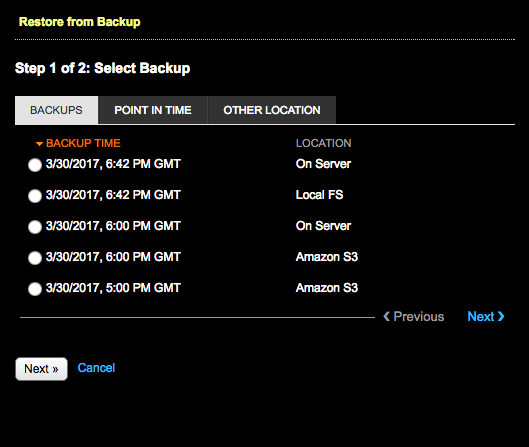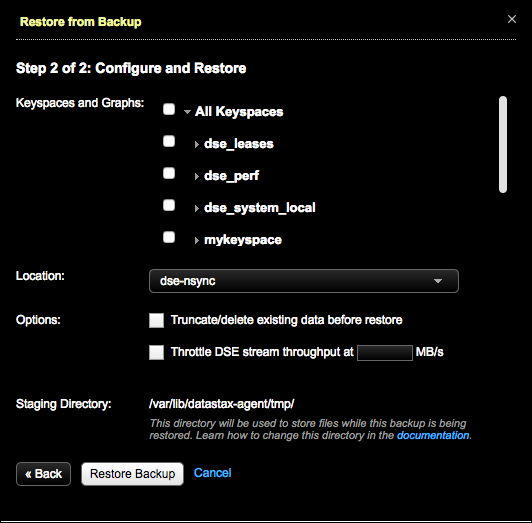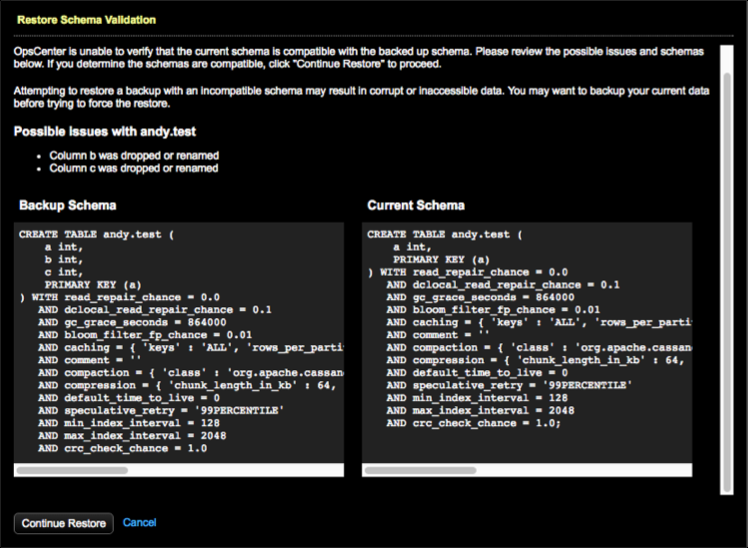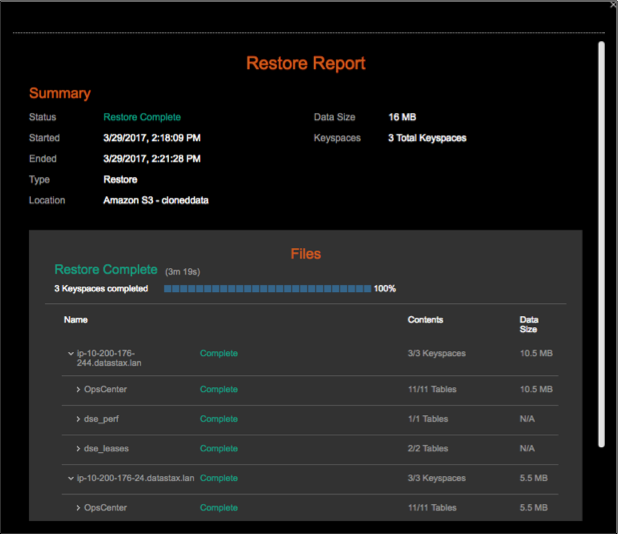Cloning cluster data from clusters managed by the same OpsCenter instance
Clone cluster data from one DSE cluster to another using the Restore Backup feature in OpsCenter. This workflow requires the source and target clusters to both be managed by the same OpsCenter instance.
Prerequisites
To clone cluster data, a backup of the cluster to a supported location must exist. See adding a backup location.
- Ensure the source and target datacenter names and topology are identical. See Managing datacenter topologies and Cloning cluster data.
- Ensure the encryption keys are identical when cloning encrypted tables to a different cluster.
Procedure
- Click the source .
- Click the Details link for the Backup Service.
-
In the Activity tab, click Restore
Backup.
The Restore from Backup dialog appears.

-
In the Backups tab, select the backup that contains the
data you want to clone and click Next.
Note: On Server backups are not eligible for cloning.The Restore from Backup: Step 2 of 2 dialog appears.

-
In Keyspaces and Graphs, select the tables or graphs
included in the backup you want to restore.
- Click the keyspace name to include all the tables in the keyspace. Click All Keyspaces to restore all the keyspaces. To select only specific tables, expand the keyspace name and select the tables.
- Click the graph name to include all the graphs in the keyspace. Click All Graphs to restore all the keyspaces. To select only specific graphs, expand All Graphs and select the graph keyspaces.
-
Under Location, select the target cluster for the
restored data. Select a different cluster than the one that was backed up to
clone the data to the cluster.
The Location list is only available when there are multiple clusters and both clusters are managed by the same instance of OpsCenter.
- When cloning data, it is not necessary to select the Truncate/delete existing data before restore option because it is a no-op for a cloning workflow. The truncate option purges data on a target before a restore runs. When using the restore feature to clone, the truncate option does not do anything because there is no data to purge before the restore runs.
- To prevent overloading the network, set a maximum transfer rate for the restore. Select Throttle DSE stream throughput at ____ MB and set the maximum MB per second.
- Optional:
Change the staging directory if necessary by setting the
backup_staging_directoryconfiguration option in address.yaml. -
Click Restore Backup.
The Confirm Restore dialog appears.
 Warning: If a value was not set for throttling stream output, a warning message indicates the consequences of unthrottled restores. Take one of the following actions:
Warning: If a value was not set for throttling stream output, a warning message indicates the consequences of unthrottled restores. Take one of the following actions:- Click Cancel and set the throttle value in the Restore from Backup dialog.
- Set the
stream_throughput_outbound_megabits_per_secandinter_dc_stream_throughput_outbound_megabits_per_secvalues in cassandra.yaml. - Proceed anyway at the risk of creating network bottlenecks.
Tip: If you are using LCM to manage DSE cluster configuration, update Cluster Communication settings in cassandra.yaml in the config profile for the cluster and run a configuration job. Stream throughput (not inter-dc) is already set to 200 in LCM defaults.
-
Click Start Restore to confirm the restore.
If the pre-restore checks detected schema differences that could not automatically be validated, the Restore Schema Validation dialog appears. Possible issues are listed and a comparison of the backup and current schema are presented side-by-side.

-
Review the information to determine what adjustments if any need to be made to
the current schema:
- To rectify the schema issues and try the restore again afterward, click Cancel.
- To proceed despite the schema mismatch, click Continue
Restore.Warning: Attempting to restore a backup with an incompatible schema might result in corrupt or inaccessible data. Before forcing the restore, back up your current data.
Results
The details and progress of the restore operation are displayed in a progress dialog, and also appear in the Backup Activity of the target cluster. If you close the progress dialog, track the progress and status of the restore in the target cluster's Backup Activity section.
The progress and details of the restore operation are displayed in the Restore Report.
